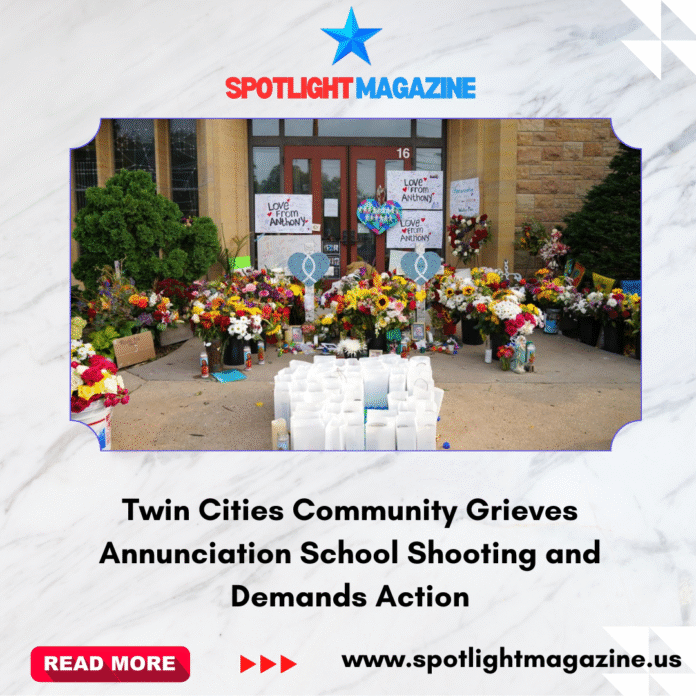It has been nearly two weeks since the tragic shooting at Annunciation Catholic School in the Twin Cities, one of the most devastating school shootings the area has seen in recent years. The pain of the incident continues to ripple through the community, touching many at the University of Minnesota who feel a personal connection to the victims and their families.
For many, the tragedy feels close to home. Ella Knoell, a fourth-year University student, described how the shooting affected her personally. “I worked at a country club in Uptown, so I know people who went to that school. My friends had friends at that school that day,” she said. “Obviously, it’s never good to hear about a school shooting, but when it’s in your backyard, it kind of hits harder, especially when you know the kids that were killed.”
In the aftermath, the Twin Cities community has shown remarkable solidarity with the school. Across neighborhoods, blue and green ribbons—the school’s colors—are tied to trees, streetlamps, and poles to honor the victims. A Facebook group called Linden Hills Neighborhood Forum even created a website called Bows of Love, which helps coordinate support efforts. Through the site, people can find opportunities to volunteer, donate, or request ribbons to spread the message of unity and compassion.
But alongside the mourning has come a strong call for action. Protests have been held across Minnesota, with many demanding solutions to the ongoing problem of gun violence. During Vice President J.D. Vance’s visit to Minneapolis, Leah Kaiser, the mother of a child critically injured in the shooting, shared a powerful message. Quoting an African proverb, she said, “When you pray, you move your feet,” urging leaders and citizens alike to pair words with action.
Knoell echoed this frustration and emphasized the need for more than symbolic gestures. “You need to get mad,” she said. “There needs to be community initiatives, but I just don’t know how effective they’ll be compared to actually banning AKs. Why do we have guns that are literally designed to kill people?”
Public Health Professor Patricia Jewett agreed that easy access to firearms is at the core of the problem. “The reality is I really truly do believe that 99% of gun owners in the U.S. are responsible,” she said. “But we live in a country where it’s very easy to get access to a firearm, and the one percent who are not responsible can do a lot of harm.”
Statistics back up her concerns. According to the Commonwealth Fund, the United States ranks in the 93rd percentile worldwide for overall firearm deaths, in the 92nd percentile for children and teens, and in the 96th percentile for women. Jewett said these numbers reveal how badly the nation is failing to protect its children. “When you compare the U.S. to other countries in the OECD, the risk ratios of firearm injuries are horrifying,” she said.
For some, however, fear has been dulled by the constant presence of gun violence in American life. Jesse Thomas, a fourth-year student at the University, admitted he felt numb to the tragedy. “Even with the shooting threat a couple winters ago, I wasn’t particularly shaken by it,” he said.
Jewett, who is also a mother of school-age children, described this numbness as a natural response to living in a country where gun violence has become a backdrop to daily life. “We live in this society where it’s just normal to be afraid, right? It’s like the background radiation to our lives,” she explained. “We always expect that this might happen. It’s unlikely that it will, but it’s not impossible.”
For now, the community continues to grieve while pushing for change. The ribbons, protests, and shared voices are a reminder that healing will take time—but also that many are determined to ensure tragedies like this no longer feel like an inevitable part of American life.


